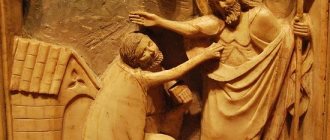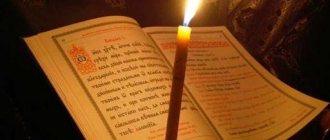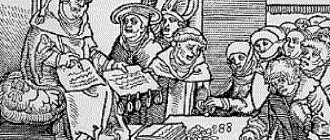| TV Tropes For English speakers and those who want to become even more familiar with the topic, the TV Tropes project has an article Purgatory and Limbo. You can also help our project and transfer valuable information from there to this article. |
| « | Raising the sail now for better waters, My genius again strives for its boat, Wandering in such a furious abyss, And I will sing of the second kingdom, Where souls find purification and ascend to eternal existence. | » |
| — Dante, The Divine Comedy, trans. M. Lozinsky | ||
This pretty island is the Tower of Babel Purgatory, as Dante saw it in The Divine Comedy.
Many religions have the concept of an afterlife judgment, which determines the posthumous destiny of human souls. Some who were good people during their lifetime ascend to heaven. Others, who have done a lot of evil and were unable to earn forgiveness even by death, are sent straight to. But what if the dead man on trial is an anti-hero who is in the middle of the scale of good and evil? And you can’t just let him into heaven, and he’s too good for hellish torment... In some settings, there is purgatory
.
Purgatory is a special place in the afterlife where people must repent of their sins before being allowed into heaven. As a rule, here a person must undergo tests to cleanse his soul from sins. What kind of tests these will be and what purgatory itself will look like depends on the author’s imagination. From an afterlife office with life indistinguishable from earthly life to a fantasy phantasmagoria or even being in the void. In some cases, Purgatory is the only place in the afterlife where souls await rebirth.
Limbo (Latin Limbus, English Limbo), which some authors describe as a type of Purgatory, deserves special mention. However, in The Divine Comedy, Limbo is the first circle of hell where virtuous non-Christians go.
Canon[edit]
According to the teachings of the Catholic Church, after death those who died in peace with God (that is, were not an atheist, a conscious Satanist, a heretic, an infidel or a frostbitten villain) go to Purgatory, but have unforgiven sins in their souls that they did not have time to repent of. in life. For them, in the next world, seven circles of atonement are organized, each of which gives them the opportunity to recognize the corresponding sin (from the canonical list), repent of it and purify themselves (hence, in fact, “purgatory”).
Suspiciously similar to the concept of hell in Judaism. Theft or convergence?
Purgatory is a place between hell and heaven, but the vector of movement here is always upward. Souls experience torment, but, unlike hell, this torment is temporary. Everyone who ends up in Purgatory will eventually end up in paradise, in which they can be helped by the prayers of those living on earth and the saints in heaven.
The concept of Purgatory is absent in the Old and New Testaments (they speak only of the afterlife purifying fire), but only developed in the 12th century, after which it was consolidated by several councils and officially adopted by a papal bull in 1254.
Modern Catholic theology no longer considers Purgatory a specific location (see below about Dante), but argues that it is a state rather than a place. Purgatory will exist until the Last Judgment, when hell will be finally sealed, and instead of heaven, saved souls will be offered a new Heaven and a new Earth for eternal life.
Why is the path to heaven so long?
To get to Dante's paradise in The Divine Comedy, you need to overcome a long journey, on which it would be nice to stock up on, as Osip Mandelstam figuratively wrote, “a pair of unwearable Swiss shoes with nails.” It is not without reason that when talking about the “Divine Comedy”, people most often remember its first part, “Hell,” and least often, “Paradise.”
I think the reason here is the same as why the most popular telegram channels today are those publishing gossip, dirt, etc. After the Fall, everything base and passionate is closer and more understandable to man. In the words of Vasily Rozanov, “vice is artistic, but virtue is so dull.” Try again to find virtue in this world, and then describe it in such a way that it is bright and interesting...
The Angel of Peace shows the way. Engraving by Gustave Doré
But the third part of The Divine Comedy is objectively in no way inferior to the first two. There are a lot of brilliant ideas and colorful characters. We find in paradise not only disembodied angels, but also St. John Chrysostom, and St. Benedict of Nursia, and Justinian, with whom Dante conducts interesting and enriching conversations. The apostles Peter, James and John give Dante a theological examination, after which the hero will have a conversation with the forefather Adam.
In Dante's paradise there are sounds, bright colors, and unusual sensations:
It seemed to me that we were covered with a cloud, Transparent, smooth, strong and thick, like the adamant that the sun struck.
And this pearl, eternally indestructible, took us inside, like water - a ray of light, without sacrificing its substance.
Schelling also noted that the three kingdoms of the Divine Comedy correspond to the three spheres of art: hell is like sculpture, purgatory is like painting, and heaven is like music. But music is a whole universe!
If Virgil, the image of earthly wisdom, was his guide in hell and purgatory, then in heaven Dante is accompanied by his Platonic beloved Beatrice, a symbol of heavenly wisdom. It’s amazing how an ordinary girl, seen by Dante only a couple of times in his life, was transformed into such a beautiful and comprehensive symbol, an allegory of heavenly beauty and wisdom! In my opinion, the image of Beatrice alone is already worth reading The Divine Comedy to the end.
Alternative points of view[edit]
- The Orthodox reject the doctrine of the Catholics, but use their own concept called ordeal
. This is the space between earth and sky (“air sphere”), where the soul on its way to heaven is met by outposts of evil spirits, who remind the newly deceased of all his earthly affairs. Demon prosecutors read lists of sins, and the guardian angel excuses them with reminders of good deeds. If the latter are not enough, the soul is pulled off with hooks and dragged into the inferno while an angel cries. But a sinner can be rescued from hell through the prayers of the church. From a theological point of view, ordeals are not purgatory, but an image of a private judgment after death. A separate item is the non-canonical legend about a merciful fornicator who was virtuous, gave generous alms, but remained in the sin of fornication until old age. After his death, God revealed to the believers his posthumous fate: to remain between heaven and hell until the Last Judgment, falling neither there nor there.
) between hell and heaven, on which, like boys on a fence, undecided souls sit, contemplating both perspectives at the same time. They want to go to heaven (where they are not allowed) and are afraid of the underworld, which is why they begin to cry out to Allah much more diligently than during life. In the end, Allah will have mercy on everyone.
- Japanese purgatory - Meido
- is somewhat more hardcore than Christian hell, judge for yourself. This purgatory is needed to figure out in which world the dead person should be reborn. Many end up in Jigoku.
and means the state between death and rebirth. In fact, this Tibetan word refers to any intermediate state of the soul, including between birth and death, between falling asleep and waking up, between the beginning and end of meditation.
In art, the image of Purgatory is often used as a metaphor for the harsh trials and unpleasant vicissitudes that fall upon the hero like a swift jack - sometimes as karmic retribution, sometimes simply as a result of the imperfections of the universe. Not fatal, but long, painful and usually associated with internal change (not always for the better).
What did they say about Purgatory?
What could those who found themselves there during their lifetime see in Purgatory? The author of the book recounts a number of fascinating stories, including “The Vision of Tnugdal,” written down first in Latin and then translated into 15 languages. Perhaps it was this that influenced Dante when he wrote his “Divine Comedy”.
The hero of this story, being very sinful, one day fell as if dead and was almost buried, but was still considered alive. And at this time he, together with his guardian angel, wandered through Purgatory. Here he sees an icy swamp, where a terrible iron bird sits, devouring souls and spewing them back. All men and women, having been in the belly of a bird, conceive a terrible fetus.
Tnugdal himself suffered a lot of suffering. And even having reached those spheres where almost worthy souls live, he sees one of the glorious kings of Ireland, who, for adultery and an unjust trial, is doomed to stand in the fire three hours a day. But he spends the rest of his time in relaxation and well-being.
But the knight Owain descended just into the Purgatory of St. Patrick, where he was first met by angels in the guise of monks, and then a roaring flock of demons flew in. He also saw suffering souls - sinners were devoured by dragons, bitten by snakes and toads, they were nailed to the ground... Owain himself was pushed into the abyss of hell by the demons, but calling out to Christ, he got out of there. Then he had to cross a thin bridge over a burning sulfur river. But Owain was not so sinful, so in the end the bridge became wide and reliable.
Examples[edit]
Theater[edit]
- V. Mayakovsky, “Mystery-bouffe” - with a screwed-on wick: in hell the characters see a door with the inscription “Purgatory” and exit from there through it, but the stay in purgatory itself is not shown in any way - in the next act they are already in heaven. Perhaps the author meant that this is only a minor “tambour” between hell and heaven.
Literature[edit]
- Dante, "The Divine Comedy" - codifier. The author describes Purgatory as a huge island in the ocean with a seven-tiered mountain in the center. The mountain is a hump of earth that swelled in the middle of the southern hemisphere after the fall of Lucifer. On the other side of the ball, at the opposite point, there is the actual place of the fall - the same seven-tiered crater, resting on the center of the Earth. The devil is stuck at the bottom, and hell is huddled along the walls.
- Charles de Coster, “The Legend of Ulenspiegel” is a zigzag in Soetkin’s vision of the posthumous fate of Emperor Charles V. On the one hand, the heroes by that time are already Protestants who deny purgatory, and according to this vision, Charles goes “to the very depths of the underworld.” On the other hand, it is directly said that after three hundred years of torment he can correct himself and still go to heaven (which most likely corresponds to purgatory).
- D. Andreev, “Rose of the World” - all the lower layers, with the exception of the last, where the final death of the soul occurs - namely purgatory, where the period of stay is finite. Even for Judas Iscariot. Purgatories became such only after the descent of the Planetary Logos into them, and before that they were quite hellish circles for eternal stay there. More precisely, no one even assigned them to the residence of human souls burdened with sins; it happened naturally according to the laws of local metaphysics, and suited everyone.
- J. R. R. Tolkien, "The Leaf of Niggle's Work" - the death and post-mortem of the main character is described very allegorically, but he clearly remains in purgatory for some time.
- Alexander Rudazov, “Ghost” - the protagonist, having wandered around the Earth and several afterlife worlds after death, gets a job in Purgatory with the aim of earning a pass to Paradise in a few decades. There are a lot of them there - with a sight. Moreover, if Hell and Paradise are mechanically copied by Dante, then Purgatory... well, sort of the same, but still has changed a lot over the past eight hundred years, because the newly departed’s ideas about reality have changed - and Purgatory adapts to them.
Cinema[edit]
- Alexander Nevzorov’s military drama “Purgatory” (1997), dedicated to the war in Chechnya. It’s not very clear what the author wanted to say with this name - judging by the abundance of black stuff, we are most likely talking about one of the circles of hell, but Glebych already used the name “Hell” for a 1995 documentary. We can’t wait to see the film “Paradise” on the same topic, as the great Dante bequeathed.
TV series[edit]
- “Swamp” - afterlife is presented as a kind of analogue of purgatory, or, as one of the characters calls it, a pre-trial detention center.
Anime and manga[edit]
- Angel Beats! - is a simulation of a boarding school, inhabited by local NPCs.
- Death Parade - and here Purgatory looks like a bar where the dead are forced to participate in various games. It is thanks to deadly games that judges can determine who is worthy of rebirth and who will go into oblivion.
Video games[edit]
- Limbo - the name seems to hint.
- Grim Fandango - for traveling salesman Manny Calavera, a posthumous contract to transport the deceased to the afterlife serves as a kind of Purgatory (working off a karmic debt, upon completion of which his soul will be liberated).
Shakespeare, Calderon and ancient myths
As you know, in the Catholic tradition there is the idea of Purgatory. This is an afterlife where the souls of people who are not bad enough for hell, but still too sinful to ascend to heaven, suffer hellish torment. But not forever, but for some time to finally be cleansed. Remember how Shakespeare's Hamlet talks to the ghost of his father? He not only tells how and by whom he was killed, but also complains that death overtook him suddenly, without repentance and communion. This means that now he must languish in hellish fire until he atones for earthly sins...
There are many legends associated with the name of St. Patrick. One of the most famous goes something like this: he was very saddened that the Irish did not listen too carefully to his sermons and did not want to accept Christianity. Patrick prayed earnestly, asked for help - and Christ appeared to him. At the command of the Lord, the saint drew a large circle in a certain place with his staff. And inside that circle the earth opened up, a deep well formed... Anyone who wants to go down into it must not bear another repentance and will not end up in another purgatory for their sins. However, most people will not return from there.
The story of St. Patrick's Purgatory turned out to be surprisingly consonant with pre-Christian myths from different countries about heroes who descended into the underworld. In Ireland and other Celtic lands there are even tales of earthly kings who temporarily changed places with the kings of the other world.
The great Spanish playwright Calderon, who is often put on a par with Shakespeare, even wrote about the discovery of a passage into the terrible depths of his famous drama “The Purgatory of St. Patrick.” The creator of the oldest existing globe, Martin Beheim, marked on it the very entrance to Purgatory - along with the capitals of large states. That is, “a certain place” from the legend very quickly became completely real and concrete - an island on Lough Derg, which is described in Dilshat Harman’s book “The Purgatory of St. Patrick - and Other Legends of Medieval Ireland.”
Purgatory as a social institution[edit]
The main task of Purgatory is the development and formation of personality during that difficult period when the personality has completed the first stage of its existence, parting with the material shell. It is in Purgatory that a person first comprehends the whole essence of existence, as well as the meaning of life, which boils down to a constant search for the meaning of life and shaving barbers.
Purgatory gives the individual all the necessary skills and knowledge that will be useful to him in Eternity; first of all, he introduces him to a new, non-material form of existence. After some indefinable period of time, the person moves, depending on the degree of comprehension, to one of the following social institutions: Paradise (budget), Paradise (on a paid basis), Hell (for a period of one and a half relative eternities [2]) or Peace (for a period of absolute eternity [3]). In particularly advanced cases, it is possible to return to the material shell and go through the first stage of existence again.
Did it exist or not?
Moreover, now on the island there is no such entrance to Purgatory. According to various evidence, it was walled up quite a long time ago. There is not even exact information about where this cave was. The medieval novel “Fortunatus and His Sons” tells that the noble traveler Fortunatus, finding himself on the island, learned that there was a path to Purgatory and wanted to go down. The entrance was already equipped with a door and was located behind the altar of the church of the local monastery. The abbot gave the guest the key, Fortunatus and the servant went into the cave. And they disappeared! Confusion reigned in the monastery until an old man ventured down after him, taking a ball of thread to find a way out. He found Fortunatus and the servant almost unconscious and was able to bring them to the light. After this, the abbot ordered the entrance to be walled up.
Another version says that a certain skeptic made his way into Purgatory and then wrote a pamphlet saying that there is nothing there, the cave is like a cave, no different from others like it. After this, the entrance was walled up by order of the Pope himself. Where he was is now not known exactly. Perhaps it not only was, but still remains - under one of the buildings on the island.
You can read an excerpt from the book at the link:
https://clck.ru/MYHn7
Until new books!
Your Book24
Buildings of Purgatory[edit]
Despite its changeable appearance, in any of its images it has certain structures, namely:
- Main Hill, where the main cleansing processes take place
- A gutter for soul cleansing
- Metamorphic field generator, thanks to which Purgatory has the ability to change its appearance
- A place where you can call the guardian angels of law and order
- A shoe store whose motto is “It’s not good to walk around in bad shoes, even if you’re dead.”
- Augean stables just in case
- Political officer's house
>Barefoot on cold stones
The tradition of pilgrimage to St. Patrick's Purgatory originated in ancient times and has survived to this day. Pilgrims walked to Lough Derg through forests, swamps, rocks - certainly barefoot. Having crossed to the island, they descended into a crevice surrounded by a fence among the rocks. And they remained there for many hours, continuously praying. Legend said that anyone who dozed off in the darkness and interrupted prayer was immediately dragged away by demons.
The complexity of the path and the pilgrimage itself correlated with the theme of the test bridge mentioned above. In some legends, it was not only narrow, but also covered with sharp iron spikes. Only humility could help overcome it. And in the old novel “The Knight of the Cart,” Lancelot generally had to overcome the sword bridge, walk or crawl straight along the blade.
Now pilgrims can use transport to get to the lake. But then you still have to take off your shoes and walk around the island barefoot. And then pray all night in the open air. And so on for three days. At the same time, there is a strict fast; you cannot eat at all on the island on the first day. On the second day, they give you a cup of tea and a loaf of bread. They don’t particularly like tourists here – there isn’t even a souvenir shop on the island. But for the Irish, whether they live in their homeland or in any other country, the pilgrimage to Lough Derg is the most important custom. The only thing comparable to it is climbing Mount St. Patrick, also barefoot and in the night - towards the dawn.









